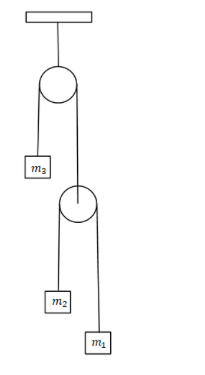Question
Question: Three masses \({m_1}\),\({m_2}\) and \({m_3}\) are attached to a string as shown in the figure. All ...
Three masses m1,m2 and m3 are attached to a string as shown in the figure. All three masses are held at rest and then released. To keep m3 at rest, the condition is:

A) m31=m11+m21.
B) m1+m2=m3.
C) m34=m11+m21.
D) m11+m22=m33.
Solution
The tension in the string always acts away from the body so the tension on the string is always equal to the weight of the mass if the mass is in rest. The tension in the pulley is T then the tension in the string holding that pulley has double tension.
Complete step by step solution:
It is given in the problem that the masses m1,m2 and m3 are attached to a string and all the three masses are rest and then released also it is given that the mass m3 will be at rest. The free body diagram will be.

The tension in the string is equal to,
⇒T=2T1………eq. (1)
The equation involving the mass m1 is equal to,
⇒T1−m1g=m1a
Since, T=2T1
⇒2T−m1g=m1a………eq. (2)
The equation involving the mass m2 is equal to,
⇒−T1−m2g=m2a
Since, T=2T1 therefore we get,
⇒−2T+m2g=m2a………eq. (3)
Dividing equation (2) by equation (3) we get,
⇒−2T+m2g2T−m1g=m2am1a
⇒−2T+m2g2T−m1g=m2m1………eq. (4)
As the mass m3 is at rest is given by,
⇒T=m3g………eq (5)
Replacing the value of equation (5) in equation (4) we get,
⇒−2T+m2g2T−m1g=m2m1
⇒−(2m3g)+m2g(2m3g)−m1g=m2m1
⇒(2−m3g+2m2g)(2m3g−2m1g)=m2m1
⇒m2×(2m3g−2m1g)=m1×(2−m3g+2m2g)
⇒m2×(m3g−2m1g)=m1×(−m3g+2m2g)
⇒m2m3g−2m1m2g=−m3m1g+2m1m2g
⇒m2m3−2m1m2=−m3m1+2m1m2
⇒m2m3+m3m1=4m1m2
⇒m1m21(m2m3+m3m1)=4
⇒(m1m3+m2m3)=4
⇒m34=m11+m21.
The relation of the massesm1,m2 and m3 is equal tom34=m11+m21.
The correct answer for this problem is option C.
Note: The masses m1 and m2 will move with acceleration a but the acceleration of the mass m3 will be given as zero therefore the tension is equal to the weight of the massm3. It is advised to the students that the equation should be designed very carefully as the equations only will help us to solve this problem.
